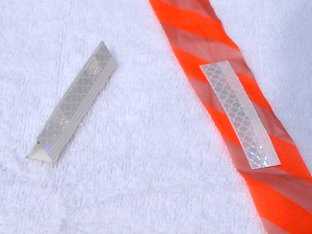High Intensity Reflectors for Marking Night Trails
Written by Bruce R. Copeland on September 06, 2009
Tags: course marking, engineering, glow sticks, headlamp, optical, races, reflectors, technology
The 2009 Bear 100 will be using high-intensity reflectors instead of glow sticks to mark the night time part of the course. Ultra trail races have for years used glow sticks to mark the trail at night. While glow sticks do a decent job indicating night time routes, they are abhorrent in many other respects. Glow sticks are expensive; they generate complaints from other trail users; they are environmentally unsatisfactory; and they require a special trip over the course for placement (because of their short life time). Here at the Bear 100, we have been searching for a good alternative to glow sticks, and we think we have found it in the form of high-intensity reflective film or tape.
There are actually quite a variety of high-intensity reflective materials available. The material we are using is 3M Scotchlite Diamond Grade 983 reflective tape. A great deal of optical engineering has gone into this and related products, yielding a very high reflectivity even at low light levels (RA ~ 800 cd/lux/m2 at optimal angles) and good reflectivity at low angles from the reflective surface (RA ~ 300 cd/lux/m2 at 45 degrees). This material is also highly durable (seven to ten year life), meaning we should be able to reuse these reflectors for quite a few races.
We will be deploying reflectors as 1/2 in. x 3 in. strips attached to standard plastic flagging. This shape is similar to a glow stick and will hopefully make it easier for runners to make the transition from glow sticks to reflectors. The linear shape should also increase the likelihood that reflectors will still be visible when partially obscured by foliage. These strips cost roughly 13 – 14 cents apiece. In testing, these reflectors are easily visible at 100 yards—similar to glow sticks.
Reflectors are not a one-for-one replacement for glow sticks. Glow sticks require no other light to be visible, whereas reflectors can only be seen in the beam of a strong light. In fact high-intensity reflectors are most visible only when the light beam originates close to a viewer’s head. For example, during testing one of us used a hand-held light at hip height and was unable to see a reflector that was clearly visible to someone else wearing a headlamp. Of course, these days the overwhelming majority of night runners use headlamps or some type of light which can be positioned near the head. We fully expect that runners will quickly adapt to this new reflector technology.
With flat reflector strips, there is also the risk that the strip might get turned in such a way that it will not be visible. To some extent we will get around this problem by simply using reflectors more frequently than we would use glow sticks. Positioning the reflector close to the knot on a piece of survey flagging does a lot to guarantee that the reflector will face in the desired direction. Flagging with a reflector can also be tied at each end or tied snugly around a tree branch or trunk to force presentation of a consistent reflector surface. Reflectors themselves can also be attached to tree bark using a push pin or staple gun. Finally in situations where visibility is critical or needed from multiple directions, three reflector strips can be taped together with packing tape to produce triangular tube reflectors. Flagging can be threaded through these triangular tube reflectors and hung anywhere flagging would normally be used.
We believe high-intensity reflectors will be a huge improvement over glow sticks, and we look forward to seeing what kind of reaction they get from runners.






